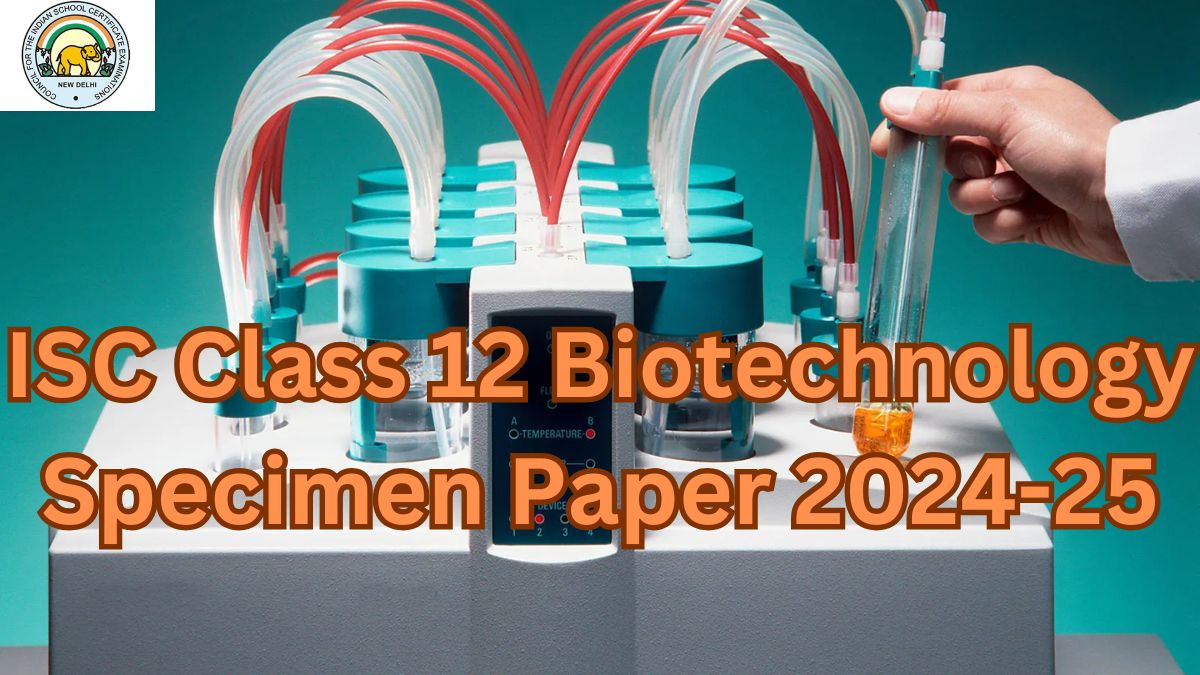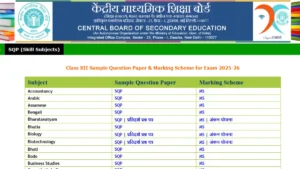The Council for the Indian School Certificate Examinations (CISCE) has released the official specimen paper for the Biotechnology subject. The ISC Biotechnology specimen paper 2024-25 PDF is available for download on the official portal of CISCE at cisce.org as well as in the article below. The ISC Class 12 Biotechnology specimen paper 2025 contains the practice questions for the upcoming ISC board exam expected to be held in February-March 2025.
ISC Class 12 Biotechnology Specimen Paper 2025
The ISC class 12 biotechnology Specimen paper 2025 include crucial questions that could appear in your 2025 board exam. Hence, through completing the Biotechnology specimen paper, students can enhance their exam readiness.
The ISC biotechnology Specimen Paper 2024-25 contain example questions from the most recent Biotechnology curriculum, mirroring the format seen in the Class 12 exams. By utilizing the Biotechnology Specimen Paper for practice, you can improve your preparation for the Class 12 exams administered by the Council for the Indian School Certificate Examinations and strive for a perfect score of 100%.
ISC Class 12 Biotechnology Specimen Paper 2024-25 Overview
The Class 12 biotechnology subject of the ISC lays the foundation for the concept of use of Mathematics and Chemistry in Biology. The ISC class 12 biotechnology curriculum and specimen paper has been carefully designed to provide students with a strong foundational knowledge to pursue biotechnology at higher education levels.
According to the ISC class 12 biotechnology specimen paper 2024-25, the theory exam paper holds the weightage of 70 marks and the practical exam has the weightage of 30 marks. Check the overview table below.
| Specifics | Details |
| Name of the Sample Paper | ISC Class 12 Biotechnology Specimen Paper |
| Academic Session | 2024-25 |
| Maximum marks for theory exam | 70 marks |
| Practical Exam Marks | 30 marks |
| Total Duration of the Exam | 3 hours and 15 minutes |
| Time given to solve the board paper | 3 hours (180 minutes) |
| Extra Time given to read the board paper | 15 minutes |
| Number of Sections in the the specimen paper | 3 |
| Name of the Exam Paper sections | A, B and C |
| Optional Questions Availability | Available |
| Section A Marks Weightage | 14 Marks |
| Section B Marks Weightage | 28 Marks |
| Section C Marks Weightage | 28 Marks |
| ISC Class 12 Biotechnology specimen paper 2024-25 status | Out |
| ISC Class 12 biotechnology specimen paper 2025 release date | September 2024 |
| Mode of availability | Online |
| Official portal | cisce.org |
ISC Biotechnology Specimen Paper 2025 Instructions
The important instructions provided for candidates in the board exam paper is also printed on the front page of the ISC class 12 biotechnology specimen paper. It is important for students to know these key instructions before hand so that they can save some precious time during the exam. The instructions mentioned on the Biotechnology specimen paper of the ISC board is given below.
- You are allowed an additional 15 minutes for only reading the question paper.
- You must NOT start writing during reading time.
- This question paper has 8 printed pages.
- There are three sections in the paper: A, B and C. Internal choices have been provided in two questions in Section B and one question in Section C.
- Answer all questions.
- Section A consists of one question each carrying one mark.
- While answering Multiple Choice Questions in Section A, you are required to write ONLY one option as the correct answer.
- Section B consists of eight questions each carrying four marks.
- Section C consists of four questions each carrying seven marks.
- The intended marks for questions are given in brackets [ ].
ISC Class 12 Biotechnology Specimen Paper 2025 with Solutions PDF
The best way to evaluate students’ progress before the biotechnology board exam is by using the ISC class 12 biotechnology Specimen Paper. The ISC Chemistry class 12 exam specimen paper assists students in grasping the types of questions that could be presented in the exam. It also assists students in understanding the relative importance of each chapter. This year, the CISCE has also provided solutions to the specimen questions in the official PDF.
Below is the PDF file containing the ISC Class 12 biotechnology Specimen Paper 2025 with solutions. Students are required to review the Sample Paper given below and solve the questions included in it. After solving the same, they should match it with the official answer key to know if they have answered correctly or not. This will assist students in achieving higher grades in the ISC biotechnology board exam.
Download ISC Class 12 Biotechnology Specimen Paper 2025 PDF
How to Use ISC Class 12 Biotechnology Specimen Paper
To maximize the effect of Class 12 ISC biotechnology specimen paper, it is important for students to follow the steps outlined below.
- Initially, make sure to complete the syllabus of the biotechnology subject and review the important concepts and equations once more.
- Afterwards, finish the ISC Class 12 biotechnology Specimen Paper as if you were taking the real exam, following the time limit and without consulting any additional material.
- Then, verify your answers by using the grading system and provided solutions. Acknowledge your weaknesses and opportunities for growth.
- Lastly, concentrate on the areas where you are not as strong and do extra practice with questions linked to those topics. Keep practicing until you feel comfortable and proficient in managing the paper.
ISC Class 12 Biotechnology Specimen Paper 2025 Questions
Some of the sample questions given in the ISC biotechnology specimen paper 2025 has been provided below for review. Students can get the complete question set in the official PDF provided above.
Question [4]
(i) Answer the following questions:
(a) In general, DNA carries a gene for a particular protein. To produce this protein, DNA synthesises RNA and RNA synthesises protein. Sometimes, few viruses contain only RNA but no DNA, still they synthesise protein. Elaborate the process of formation of DNA in such viruses. (Understanding)
(b) During plant cell culture, certain growth regulators are required for proper plant culture. Describe the role of such growth regulators. (Understanding)
Question [4]
(ii) Answer the following questions:
(a) The wavelength that are absorbed by the nucleic acid and the efficiency of its absorption during its estimation, depends both on the structure and concentration of the molecules. Elaborate any one method of nucleic acid estimation based on absorption of light. (Understanding)
(b) Radhika wishes to find out the sequence of the DNA of a strawberry plant. Suggest the steps she should follow to isolate the DNA from the strawberry plant. (Understanding)
Question [4]
State any two significant differences between the following: (Understanding)
(i) Purine bases and Pyrimidine bases
(ii) Leading strand and Lagging strand
Question [4]
(i) A study by few scientists, reports a decrease in non-target insect populations in areas where Bt crops are extensively cultivated.
(a) Explain the mode of action of the Bt toxin that provides resistance to the plants against insect infestations. (Understanding)
(b) What is the source of Bt toxin? (Understanding)
OR
(ii) Eli Lily is one of the first pharmaceutical companies to produce human insulin using rDNA technology by cell based fermentation method. (Understanding and Application)
(a) Explain how Eli Lily synthesised the human insulin.
(b) How was insulin obtained before the advent of rDNA technology?
Question [4]
Richard, a young marine biotechnologist, is designing an oil-eating bacteria for bioremediation using genetic engineering. He has chosen a particular bacterial strain and introduced specific genes to enhance its oil-digesting capabilities. Enumerate the steps Richard took while designing the recombinant bacteria for bioremediation (Analysis)
Question
(i) What is a monolayer culture? Describe how feeding and nutrient distribution are managed in large-scale monolayer cultures using roller bottles. (Understanding) [4]
(ii) Mention any three types of alignments developed by BLAST. (Recall) [3]
OR
(iii) What is the purpose of synchronizing cells in a suspension culture? Discuss any three chemical methods commonly used for synchronizing suspension cultures. (Understanding) [4]
(iv) Mention any three major database sources. (Recall) [3]
Question
(i) Restriction enzymes are also called molecular scissors. They cut the DNA at specific sites. They are of different types. Discuss different types of restriction enzymes used in rDNA technology. Who discovered these enzymes?(Understanding and Recall) [4]
(ii) Explain the 3 – D structure of DNA. (Understanding) [3]
Question
Khalid, David and Anuradha were working on yeast genome. They performed a process to digest the yeast genome and plasmid vector containing Lac Z gene with EcoRI restriction enzyme. The genomic fragment that we obtained was mixed with the cut vectors using DNA ligase. The yeast genome was inserted within the Lac Z gene of the plasmid E. coli cells were transformed with the ligation mix containing the rDNA and plated on solid agar medium containing X-Gal. They observed that some plasmid vectors self –ligated and did not carry the yeast genome.
(i) Name the enzyme that was used to ligate the yeast genome with the plasmid. (Recall) [1]
(ii) Describe the technique they can use to distinguish the non-recombinant vector from the recombinant ones.(Understanding) [1]
(iii) Why is this method of selection referred to insertional inactivation of antibiotic resistance gene? (Understanding)[3]
(iv) How could they have prevented self-ligation of the plasmid? (Application) [2]
Importance of Biotechnology Specimen Paper Class 12 ISC Board
The significance of the Class 12 ISC biotechnology Specimen Paper 2025 lies in multiple reasons.
- Provides a true representation of the actual exam’s format and structure. The sample paper consists of all the various sections and types of questions found in the actual ISC class 12 exam.
- Assistance in recognizing strengths and weaknesses can lead to enhanced preparation.
- Display the importance of every section and individual questions. Assist students in their academic readiness and provide answers in a more efficient and effective way.
- The ISC Class 12 biotechnology Specimen Paper is a crucial resource for students getting ready for the exam as it gives them a glimpse of the real exam paper. Additionally, it helps them comprehend the grading system and kinds of questions that may be featured on the test.











 AILET Sample Paper 2026 Out, Download PD...
AILET Sample Paper 2026 Out, Download PD...
 CBSE Class 10 IT Sample Paper 2025-26 PD...
CBSE Class 10 IT Sample Paper 2025-26 PD...
 CBSE Class 12 Sample Paper 2026 with Sol...
CBSE Class 12 Sample Paper 2026 with Sol...








